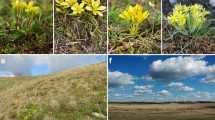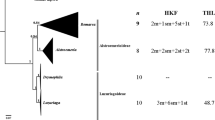Abstract
Although the South AmericanIridaceae are cytologically diverse, three tribes are distinguishable on the basis of karyotype morphology. TheSisyrinchieae andTrimezieae have variable basic numbers, ploidy levels and chromosome sizes, while theTigridieae are characterized by a relatively uniform basic number and bimodal karyotype. Changes in chromosome size within genera may suggest fluctuations in their DNA amount with latitude and altitude, particularly inSisyrinchium. The results are considered in terms of opportunities for more detailed research.
Similar content being viewed by others
References
Banerjee, M., Sharma, A. K., 1971: A cytotaxonomical analysis of several genera of the familyIridaceae. — Pl. Science3, 14–29.
Bennett, M. D., 1976: DNA amount, latitude and crop plant distribution. — Environmental Exp. Bot.16, 93–108.
—, 1982: DNA amounts of angiosperms from the Antarctic and South Georgia. — Environmental Exp. Bot.22, 307–318.
Brandham, P. E., 1983: Evolution in a stable chromosome system. — InBrandham, P. E., Bennett, M. D., (Eds.): Kew Chromosome Conference II. — George Allen & Unwin, 251–260.
Böcher, T. W., 1966: Experimental and cytological studies on plant species. X.Sisyrinchium with special reference to the Greenland representative. — Bot. Tidsskrift61, 273–290.
Bowden, W. M., 1954: A list of chromosome numbers in higher plants. 1.Acanthaceae toMyrtaceae. — Amer. J. Bot.32, 81–92.
Cavalier-Smith, T., 1978: Nuclear volume control by nucleoskeletal DNA, selection for cell volume and cell growth rate, and the solution of the C-value paradox. — J. Cell. Sci.34, 247–278.
Foster, R. C., 1962: Studies in theIridaceae VII. — Rhodora64, 291–312.
Goldblatt, P., 1971: Cytological and morphological studies in the South AfricanIridaceae. — J. S. Afr. Bot.37, 317–460.
—, 1975: Revision of the bulbousIridaceae of North America. — Brittonia27, 373–385.
—, 1979: Preliminary cytology of AustralasianIridaceae. — Ann. Miss. Bot. Gard.66, 851–855.
—, 1982: Chromosome cytology in relation to suprageneric systematics of neotropicalIridaceae. — Syst. Bot.7, 186–198.
Hair, J. B., Beuzenberg, E. J., Pearson, B., 1967: Contributions to a chromosome atlas of the New Zealand flora—8. Miscellaneous families. — N. Z. J. Bot.5, 185–186.
Henderson, D. M., 1976: A biosystematic study of Pacific Northwestern blueeyed grasses (Sisyrinchium, Iridaceae). — Brittonia28, 149–176.
Jones, K., Kenton, A., 1983: Patterns of chromosome evolution in theTradescantieae (Commelinaceae). — InSharma, A., Sharma, A. K., (Eds.): Chromosomes in Evolution of Eukaryotic Groups. — Florida: C. R. C. Press (in press).
Kenton, A., 1983: Qualitative and quantitative chromosome change in the evolution ofGibasis. — InBradham, P. E., Bennett, M. D., (Eds.): Kew Chromosome Conference II. — George Allen & Unwin, 273–282.
Molseed, E., 1970: The genusTigridia (Iridaceae) of Mexico and Central America. — Univ. California Publ. Bot.54, 1–127.
Mosquin, T., 1970: Chromosome numbers and a proposal for classification inSisyrinchium (Iridaceae). — Madroño20, 269–275.
Naranjo, C. A., Poggio, L., Brandham, P. E., 1983: A practical method of chromosome classification on the basis of centromere position. — Genetica62, 51–53.
Seal, A. G., Rees, H., 1982: The distribution of quantitative DNA changes associated with the evolution of diploidFestuceae. — Heredity49, 179–190.
Sharma, A. K., Talukdar, C., 1959: Cyto-taxonomical studies on some members of theIridaceae with special reference to the structural heterozygosity ofCipura paludosa Aubl. — The Nucleus2, 63–84.
Sprague, T. A., 1928: Bulletin of miscellaneous information 7, XLIII.,Marica andNeomarica. — Kew Bull.1928, 278–281.
Author information
Authors and Affiliations
Rights and permissions
About this article
Cite this article
Kenton, A., Heywood, C.A. Cytological studies in South AmericanIridaceae . Pl Syst Evol 146, 87–104 (1984). https://doi.org/10.1007/BF00984056
Received:
Issue Date:
DOI: https://doi.org/10.1007/BF00984056




